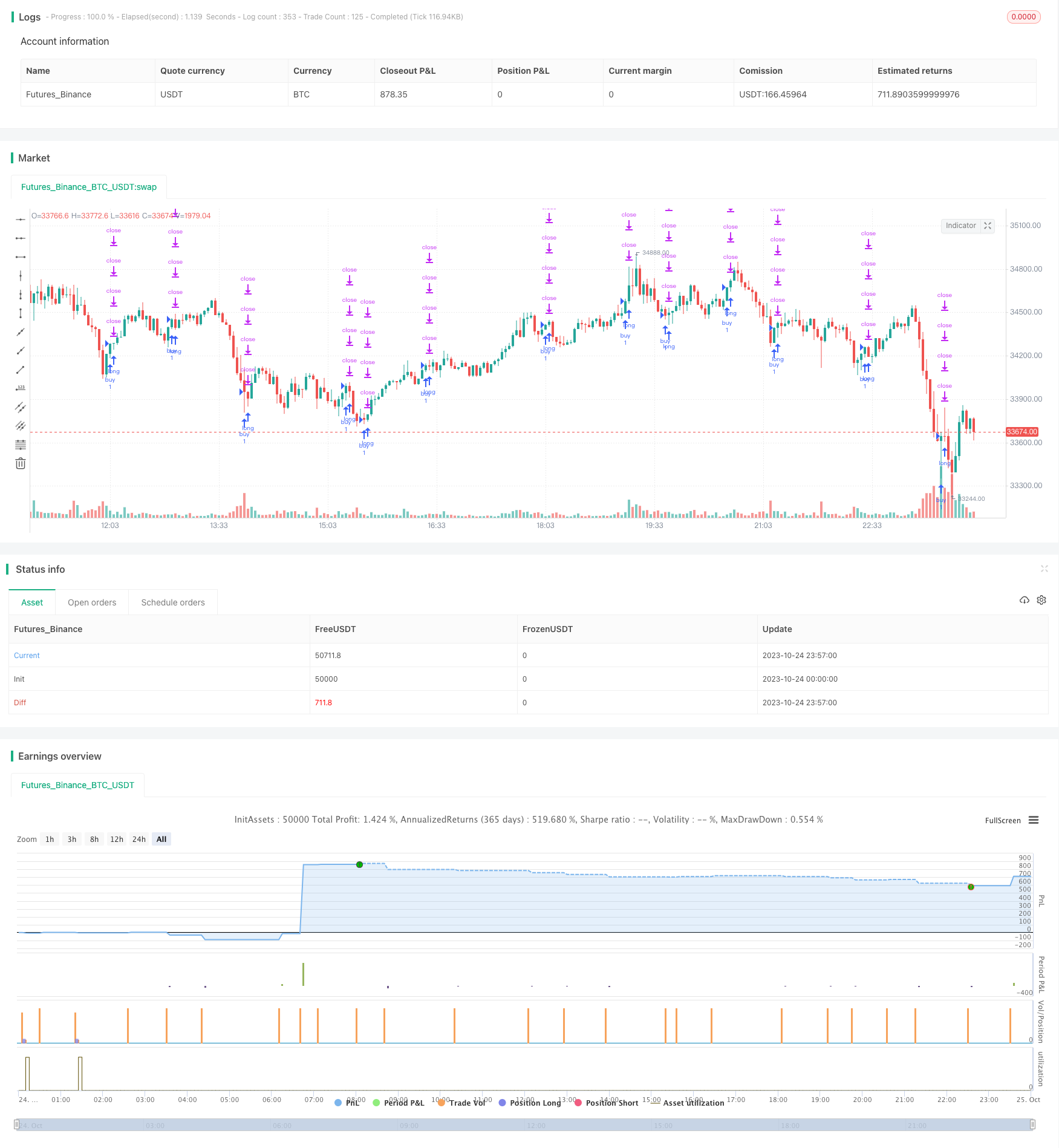
개요
하위 점 스캔 지능 추적법은 비 역동적인 Forex 거래 전략이다. 그것은 하위 점 스캐너를 사용하여 최저 지점을 찾고, 헐 이동 평균과 결합하여 거래 신호 판단을 수행하여 높은 승률을 달성 할 수 있다.
원리 분석
이 전략은 먼저 낮은 점 스캐너를 사용하여 최저점을 찾습니다. 낮은 점 스캐너는 가격과 거래량의 RSI 값을 계산하고 WMA 곡선과 비교하여 RSI 값이 WMA보다 낮을 때 최저점이라고 판단합니다.
다음으로, 전략은 Hull 이동 평균을 사용하여 거래 신호 판단을 수행한다. 그것은 두 개의 다른 기간의 Hull MA를 계산하며, 짧은 기간의 Hull MA가 긴 기간의 Hull MA를 통과 할 때 더 많은 것을하고, 낮은 기간의 Hull MA를 통과 할 때 공백을 만듭니다.
마지막으로, 전략은 최저점 스캔과 Hull MA의 신호를 결합하여 최저점 스캐너가 최저점 신호를 준 경우에만 Hull MA의 거래 신호를 발산하여 입점 전략을 형성한다.
이런 식으로, 시장의 최저 지점을 식별하고 추세를 추적함으로써, 잘못된 진입 시기를 효과적으로 피할 수 있으며, 거래 시스템의 승률을 높일 수 있다.
우위 분석
낮은 점 스캔의 장점은 다음과 같습니다.
낮은 점 스캐너를 사용하면 시장의 최저점을 정확하게 식별할 수 있으며, 높은 점에서 구매하는 것을 피할 수 있습니다.
헐 MA는 좋은 트렌드 추적 지표로, 큰 트렌드를 순차적으로 잡을 수 있다.
낮은 점 스캔과 Hull MA 상호 검증과 결합하여, 많은 양의 소음을 필터링하여 가짜 신호를 줄일 수 있다.
점진적 손실 퇴출 메커니즘을 적용하여 수익을 최대한 고정하고 회귀를 피할 수 있습니다.
이 전략은 역동적인 지표가 아니라, 역사적 데이터를 조작하지 않고, 진실하고 신뢰할 수 있습니다.
위험 분석
이 전략에는 다음과 같은 위험들이 있습니다.
최저점 스캐너는 최저점의 일부를 누락할 수 있으며, 이는 거래 기회를 놓치게 할 수 있다. 스캐닝 범위를 넓히기 위해 파라미터를 적절히 조정할 수 있다.
급격한 반전이 발생할 수 있으며, 이로 인해 중지 손실이 발생할 수 있습니다. 중지 손실 범위를 적절히 완화하고 위치 크기를 합리적으로 제어 할 수 있습니다.
잘못된 매개 변수 설정으로 인해 거래 신호가 너무 많거나 너무 적을 수 있습니다. 최적의 매개 변수 조합을 찾기 위해 여러 번 반복적으로 최적화해야합니다.
이 전략은 트렌드가 뚜렷한 FOREX 품종에만 적용되며, 평형, 흔들리는 시장의 거래에는 적합하지 않습니다.
최적화 방향
이 전략은 다음과 같은 측면에서 최적화될 수 있습니다.
최저점 스캐너의 파라미터를 최적화하여 최저점을 더 정확하게 식별할 수 있도록 한다.
헐 MA의 파라미터를 최적화하여 트렌드를 보다 정확하게 추적할 수 있도록 한다.
MACD, KDJ 등과 같은 다른 지표 필터를 추가하여 신호의 신뢰성을 높인다.
기계 학습 모델 예측 결과를 추가하여 거래 신호 판단을 지원합니다.
시장의 변동에 따라 동적으로 조정할 수 있도록 손해 방지 장치를 최적화하십시오.
포지션 관리 전략을 최적화하여 시스템에서 자금 관리 규칙에 따라 포지션을 동적으로 조정할 수 있도록 한다.
요약하다
하위점 스캔 지능 추적법은 높은 승률의 비 역동적인 외환 거래 전략이다. 그것은 시장의 최저점을 정확하게 식별할 수 있고, 추세가 명확할 때 순차적으로 입문하고, 점진적 인 손실을 차단하여 수익을 고정 할 수 있다. 이 전략은 최적화 할 수있는 공간이 넓고, 여러 측면에서 개선 할 수 있으며, 강력한 자동 거래 시스템으로 만들 수 있다.
/*backtest
start: 2023-10-24 00:00:00
end: 2023-10-25 00:00:00
period: 3m
basePeriod: 1m
exchanges: [{"eid":"Futures_Binance","currency":"BTC_USDT"}]
*/
// © theCrypster 2020
//@version=4
// strategy(title = "Low Scanner Forex strategy", overlay = false, pyramiding=1,initial_capital = 1000, default_qty_type= strategy.percent_of_equity, default_qty_value = 100, calc_on_order_fills=false, slippage=0,commission_type=strategy.commission.percent,commission_value=0)
strat_dir_input = input(title="Strategy Direction", defval="long", options=["long", "short", "all"])
strat_dir_value = strat_dir_input == "long" ? strategy.direction.long : strat_dir_input == "short" ? strategy.direction.short : strategy.direction.all
strategy.risk.allow_entry_in(strat_dir_value)
leng=1
p1=close[1]
min=input(1440)
len55 = timeframe.isintraday and timeframe.multiplier >= 1 ?
min / timeframe.multiplier * 7 :
timeframe.isintraday and timeframe.multiplier < 60 ?
60 / timeframe.multiplier * 24 * 7 : 7
//taken from https://www.tradingview.com/script/Ql1FjjfX-security-free-MTF-example-JD/
tf3 = input("W", type=input.resolution)
ti = change( time(tf3) ) != 0
T_c = fixnan( ti ? close : na )
vrsi = rsi(cum(change(T_c) * volume), leng)
pp=wma(vrsi,len55)
d=(vrsi[1]-pp[1])
min1 =input(60)
len100 = timeframe.isintraday and timeframe.multiplier >= 1 ?
min1 / timeframe.multiplier * 7 :
timeframe.isintraday and timeframe.multiplier < 60 ?
60 / timeframe.multiplier * 24 * 7 : 7
x=ema(d,len100)
//
zx=x/-1
col=zx > 0? color.lime : color.orange
plot(zx,color=col,linewidth=1)
//
tf10 = input("W", title = "Timeframe", type = input.resolution, options = ["1", "5", "15", "30", "60","120", "240","360","720", "D", "W"])
length = input(24, title = "Period", type = input.integer)
shift = input(1, title = "Shift", type = input.integer)
hma(_src, _length)=>
wma((2 * wma(_src, _length / 2)) - wma(_src, _length), round(sqrt(_length)))
hma3(_src, _length)=>
p = length/2
wma(wma(close,p/3)*3 - wma(close,p/2) - wma(close,p),p)
a = security(syminfo.tickerid, tf10, hma(close, length))
b =security(syminfo.tickerid, tf10, hma3(close[1], length)[shift])
//plot(a,color=color.gray)
//plot(b,color=color.yellow)
close_price = close[0]
len = input(25)
linear_reg = linreg(close_price, len, 0)
//plot(linear_reg, color=color.blue, title="LR", linewidth=3)
buy=crossover(linear_reg, b)
sell=crossunder(linear_reg, b)
//
// Time period input
testStartYear = input(2016, "BACKTEST START YEAR", minval = 1980, maxval = 2222)
testStartMonth = input(06, "BACKTEST START MONTH", minval = 1, maxval = 12)
testStartDay = input(01, "BACKTEST START DAY", minval = 1, maxval = 31)
testPeriodStart = timestamp(testStartYear,testStartMonth,testStartDay,0,0)
testStopYear = input(2222, "BACKTEST STOP YEAR", minval=1980, maxval = 2222)
testStopMonth = input(12, "BACKTEST STOP MONTH", minval=1, maxval=12)
testStopDay = input(31, "BACKTEST STOP DAY", minval=1, maxval=31)
testPeriodStop = timestamp(testStopYear, testStopMonth, testStopDay, 0, 0)
testPeriod = time >= testPeriodStart and time <= testPeriodStop ? true : false
l = crossover(zx,0) or buy
if l and testPeriod
strategy.entry("buy", strategy.long)
per(pcnt) =>
strategy.position_size != 0 ? round(pcnt / 100 * strategy.position_avg_price / syminfo.mintick) : float(na)
stoploss=input(title=" stop loss", defval=25, minval=0.01)
los = per(stoploss)
q1=input(title=" qty_percent1", defval=25, minval=1)
q2=input(title=" qty_percent2", defval=25, minval=1)
q3=input(title=" qty_percent3", defval=25, minval=1)
tp1=input(title=" Take profit1", defval=0.5, minval=0.01)
tp2=input(title=" Take profit2", defval=1, minval=0.01)
tp3=input(title=" Take profit3", defval=1.5, minval=0.01)
tp4=input(title=" Take profit4", defval=2, minval=0.01)
strategy.exit("x1", qty_percent = q1, profit = per(tp1), loss = los)
strategy.exit("x2", qty_percent = q2, profit = per(tp2), loss = los)
strategy.exit("x3", qty_percent = q3, profit = per(tp3), loss = los)
strategy.exit("x4", profit = per(tp4), loss = los)